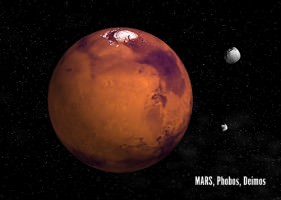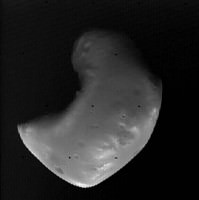The Moons of the Planet Mars: Phobos and Deimos
Since the last post focused on the Planet Mars, I thought it would be worth highlighting the two tiny moons that light up the Martian night sky. The names of the moons of Mars are Phobos and Deimos.
Let’s start with the moon that is closest to Mars, Phobos. Phobos is small – it’s radius is 11.1 km, deeply cratered, and it is not a sphere! It is closer to the surface of it’s primary than any other moon that we know of in the solar system. This causes some interesting effects. If you were to look at Mars from the surface of Phobos, it would appear 6,400 times larger than the full moon appears to us on Earth. Phobos also circles Mars faster than the planet rotates which means that it rises in the west, moves quickly across the the sky and sets in the east twice each day! Because Phobos is so close to the surface of Mars, it’s orbit is slowly decelerating. It is estimated that it will either impact the surface or break up into a planetary ring in about 11 million years.
The companion moon to Phobos is the smaller of the pair, Deimos. It is also irregularly shaped and deeply cratered. It has a radius of 6.2 km. Unlike Phobos, Deimos’ orbit is nearly circular and is close to the Martian equatorial plane. As seen from the surface of Deimos, Mars would look 1,000 times larger than the full moon as seen from Earth. Since Deimos is so small, it would look much like Venus does from the surface of the Earth. Deimos rises in the east and sets in the west. It’s orbital period is slightly longer than the Martian day, so 2.7 days elapse between it’s rising and setting.
The origin of the Martian moons is not clear. Some scientists speculate that they are captured asteroids, other scientists speculate that they were formed when the planet Mars was formed. Given their similar composition and Mars’ proximity to the asteroid belt, I’d bet they are captured asteroids. What do you think?





good pics of marz
[Reply]
i have to learn about mars for science an its an amazingh planet!! (:
[Reply]
thes are the best pics EVER
[Reply]
they look like giant rocks
[Reply]
Mars’ moons are so small, they don’t really fit that description. They are both made of the same material found on the surface of Mars and their orbits suggest they are composed of ejection material due to a large impact. Much of the surface material on the Martian surface has been blown off the northern hemisphere and redistributed south, again suggesting a very large impact.
[Reply]
It seems the lesson from the Solar System is that rocky, high-density planets don’t have moons. Mercury, Venus and Mars don’t really have moons. Those rocks around Mars won’t last all that long, one crashing and the other escaping. Luna is highly exceptional and probably the result of a colossal long-shot, a Mars-sized body hitting the planet. I would think the odds of duplicating that event would be astronomical. Just from what I see, I would not expect rocky planets in other systems to have moons at all.
[Reply]
I just like it! Amazing article! I only wish you upetdad your blog more often, I can’t seem to get enough of your blog. I keep your site in my favorites. Do you think that I could do a guest post sometime?
[Reply]
Greg - Staff Writer replied:
January 21st, 2013 at 9:37 am
Thanks for the feedback Kempul. We appreciate your loyalty to our site. If you are interested in blogging for us, please send a sample of your writing to greg@outerspaceuniverse.org. If it meets our editorial standards, we will consider posting it.
[Reply]